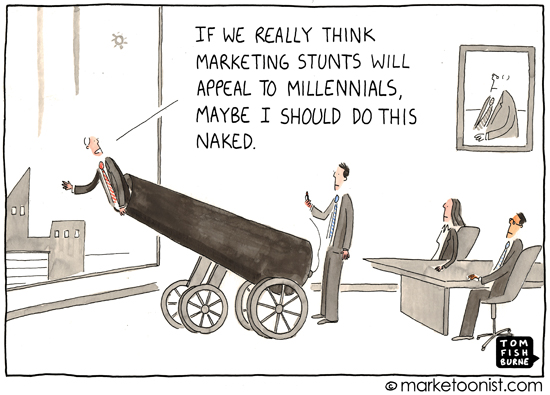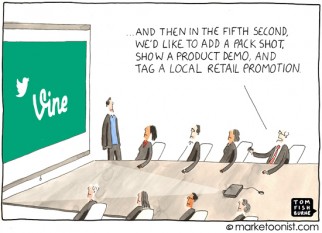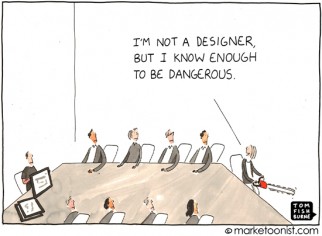RedBull achieved marketing nirvana last year when they sponsored Felix Baumgartner’s jump from a helium balloon in the stratosphere to become the first human to break the sound barrier without vehicular power.
This publicity stunt was the perfect marketing win-win. “Red Bull Stratos” captured the world’s attention and perfectly gelled with the positioning statement that “RedBull gives you wings”.
Many brands are jumping on the marketing stunt bandwagon to find their own Red Bull Stratos. Marketing stunts are nothing new of course, but there seem to be more of them than ever, which raises the bar on what will truly get attention.
This publicity stunt one-upmanship has also led to marketers using shock jock prank tactics, even if it jeopardizes the brand. Earlier this year, a Capital 8 Theater in Missouri promoted its premier of Iron Man 3 by hiring actors to dress as gunmen and storm the theater with fake weapons drawn. This was one year after the Aurora shooting.
Not all attention is good attention. Just because a stunt gets people talking doesn’t mean it’s necessarily the right fit for the brand.
In February, Nivea pulled a marketing stunt in Germany. To introduce its “Stress Protect” line of deodorants, they staged a prank at an airport, stressing out random people by making them think they were wanted criminals. They made special newspapers with the victim’s face and television alerts warning that he or she was extremely dangerous. Then the police came.
It’s funny, but in a kind of mean-spirited way. The tone doesn’t feel like Nivea to me. I get the connection to stress, but it seems like a stunt for the sake of pulling a stunt.
In the pursuit of getting attention, brands shouldn’t forget to stay true to themselves.
(Marketoonist Tuesday: I’m giving away a signed print of this week’s cartoon. Just share an insightful comment to this week’s post by 5:00 PST on Tuesday. Thanks!)



Ori Pomerantz says
A good stunt entertains. A bad one merely shocks. “This is cool” is positive. “Hey! Look at me!”, by itself, is negative.
Nivea could have done a much better stunt by giving deodorants to people who were running, about to miss their connection, along with a ride in a golf cart. Or to university students when they go in to an exam.
Neil Cowan says
Hah! Love this cartoon. Groupthink gone nuts.
You score on two fronts: (i) the notion that a loony stunt is right and (ii) that the lunacy can be improved upon! Loony and loonier!
Can’t believe the Iron Man ‘prank’. It rhymes with another word which accurately describes it.
France Anne Paris says
Nivea tried, but it wasn’t good. Live and learn. 🙂
I personally think you should marketoon something about the weird commercials the makers of toilet paper come up with. Really? We all know why we buy it. I think humor is the only way to go there.
Harvey Chimoff says
Hi Tom,
Once again, you’re on the mark. Marketers get into trouble when they forget and/or ignore that tactics have to be connected to the brand’s strategy and positioning. As you succinctly point out: “Just because a stunt gets people talking doesn’t mean it’s necessarily the right fit for the brand.” Brand Managers are trained (at least they used to be) to make the tough decisions about what, in their judgment, is best for the brand.
Harvey Chimoff
http://www.marketingworldblog.com
Connie says
OMG, that Nivea ad is horrible! They could have caused someone to have a heart attack…
I think the Kate Spade touchscreens or the Douwe Egberts coffee machine stunts were nicer and had a much more positive effect on the brand. http://www.youtube.com/watch?v=HOTQ8z0fQHo – Douwe Egberts video and http://untappedcities.com/2013/06/29/kate-spade-saturday-pop-up-nyc/
Those are fun, interesting ideas about how to do a stunt but at the same time, make it meaningful and make people happy.
April says
Like any kind of advertising, a marketing stung only really works when it is tied to the brand or it’s key attributes in some way. I predict we’ll see a lot more stunts like this in the future and most will miss the mark.
CH says
Prankvertising, used in the right context and without a mean spirit,can be amusing and say something about the brand. For example, on April’s Fools’ Day 2013, Google has surprised and delighted us with a Google Nose prank and still managed to stay true to its fun, innovative personality.
LG’s recent prankvertising involved scaring job candidates in Chile with a fake end-of-the-world scenario. While LG TV’s ultra HD benefit came across, this stunt has Adweek asked the question: “Is This the Most Evil and Sadistic Prankvertising Stunt Yet? LG’s doomsday scenario” (http://www.adweek.com/adfreak/most-evil-and-sadistic-prankvertising-stunt-yet-152212).
As more brands jump on the bandwagon of prankvertising, we have seen some of them increase the intensity with outrageous stunts victimizing innocent people. Brands need to make moves with their brand purpose and long-term brand building in mind. This has also reminded me of what Bill Bernbach said: “All of us who professionally use the mass media are the shapers of society. We can vulgarize that society. We can brutalize it. Or we can help lift it onto a higher level.”
Jann says
This reminds me of a client who sagely used to say “We want to stand out, not stick out!”
I personally hate watching these “shock” commercials that make people squirm before getting to the “aha”; I’m usually gone before then.
Vlad says
Horrible and totally unethical approach to advertising. Manipulating people and causing customers stress in order to promote a deodorant… Very dissapointing.
staffan says
Wasn’t this called ambient media 10 years ago? Although maybe without the hightened chock factor. Nothing new under the sun..